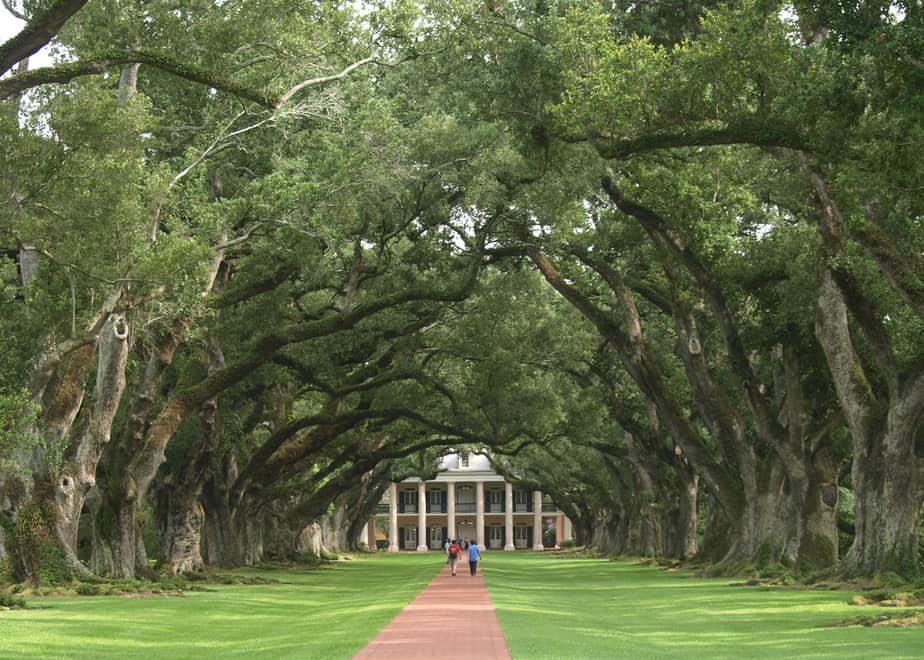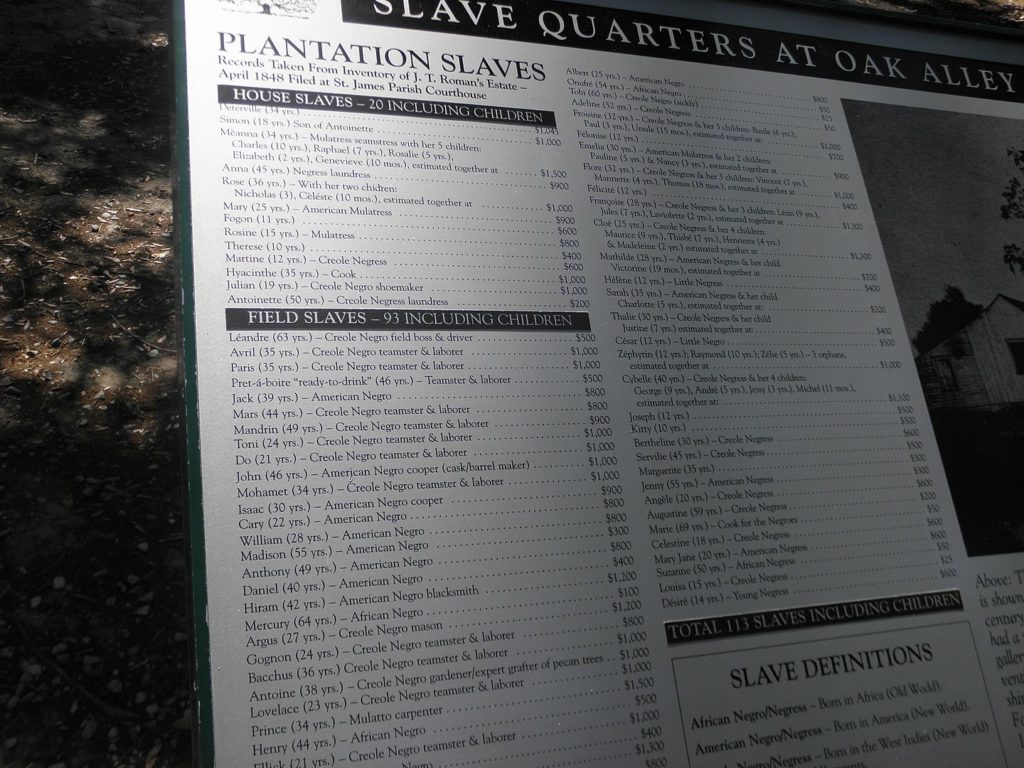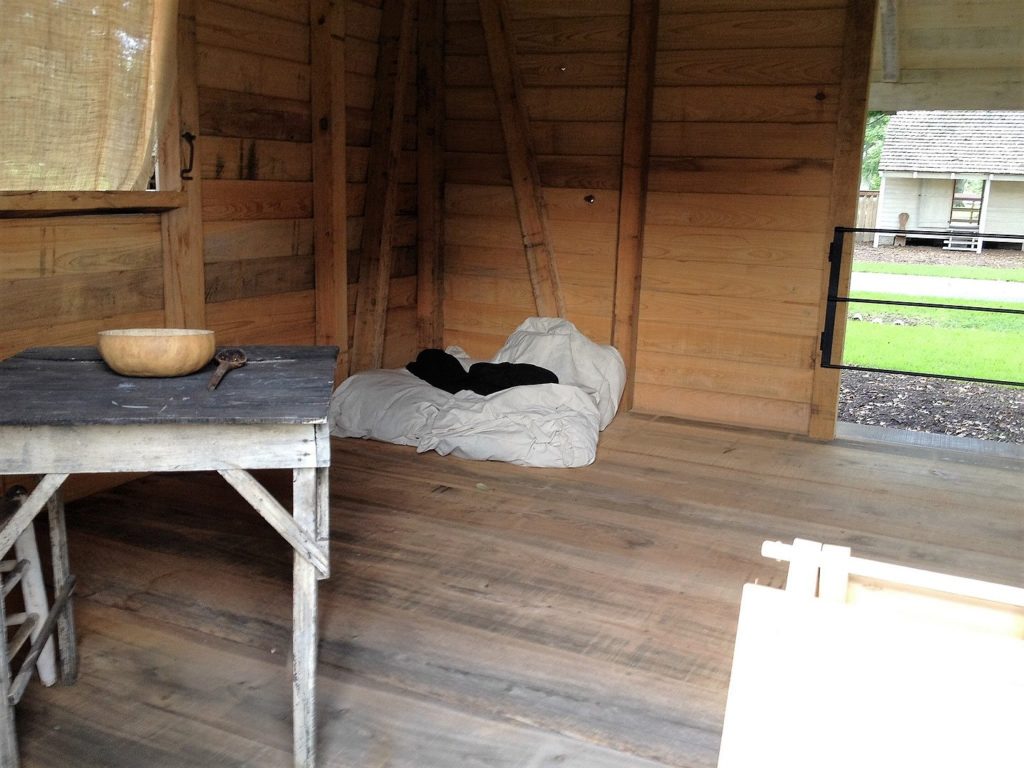
Oak Alley Plantation, looking towards the main house from the direction of the Mississippi River. Photo By Emily Richardson – Wikimedia
Top 10 Interesting Facts About the Oak Alley Plantation
Located along the fertile west bank of the lower side of the Mississippi River just outside of New Orleans is Oak Alley Plantation. It is one of the many plantations in the small town called Vacherie in the state of Louisiana.
With a history of over 170 years, the plantation is a large estate with a Big House, barns, a sugar mill, slave quarters, and 1200 acres of farmland.
Oak Alley Plantation is named for its distinguishing visual feature. A canopied path is created by a double row of 14 southern live oak trees on each side. Here are facts about Oak Alley Plantation.
1. The Alley of Oaks
At Oak Alley, in front of the plantation’s Big House stands a row of Virginia Live Oaks. An early settler planted 28 southern live oak trees in two equal rows spaced 80 feet apart. The tree avenue runs between the home and the Mississippi River.
While the alley trees are very old, approximately 300 years, the average age for a Live Oak is 600 years. These huge 800 feet long Oak trees are only middle-aged!
Each tree in the alley is named after a person who owned Oak Alley Plantation at one time over its history. The largest tree, “Josephine Armstrong Stewart” has a girth of 30 ft in circumference and has a 127 ft. limb spread.
Its namesake, Ms. Josephine, was the last owner of Oak Alley, and it was she who established the Oak Alley Foundation, which preserves the plantation today.
These trees are naturally beautiful and the tunnel they form forces air from the river to the house creating a continuous cool breeze.
2. The Big House

Oak Alley Plantation Big House. Photo By Brian Sherin – Wikimedia Commons
The mansion was built over 175 years ago by planters Jacques and Celina Roman’s slaves. The Romans chose a popular 1800s style called “Greek Revival” that mimics ancient Greek temples in Europe.
The house is a perfect square with a high ceiling whose exterior features a free-standing colonnade of 28 Doric columns on all four sides that correspond to the 28 oak trees in the alley.
The columns form an enormous porch or gallery around the entire house. This protects the house from the sun and creates a comfortable outdoor space for the family to lounge.
It has huge windows and French doors positioned directly across from each other. The house showed off how sophisticated and wealthy the Romans were as sugar planters.
3. The Bell
Messages were sent across the huge plantation by ringing this bell. It was so loud a person 2 miles away at the end of the plantation could hear it.
The bell was rung in various ways to signal work time, lunchtime, or raise the alarm if there was an emergency.
4. Slaves and Slavery

A register of the slaves kept on the Oak Alley Plantation. Photo By PandoraPanek – Wikimedia Commons
Plantations depended on slavery and Oak Alley had many slaves. Africans were brought to Louisiana and sold to planters. The Romans bought slaves from other planters or slave traders.
Most of the slaves worked in the sugarcane fields planting, weeding, harvesting and landscaping. These were called field slaves. Others worked in the Big House cooking and cleaning and were called house slaves.
The third group was the craftsmen. They did specific tasks such as making barrels and shoes, working as blacksmiths, carpenters, and other skills. They all had one thing in common, their days were long and very tiring, and they worked for no pay.
Through the years at Oak Alley, records indicate that there was a total of 220 slaves.
5. Ownership History

Oak Alley Plantation Sign describing the house. Photo By ZeWrestler – Wikimedia Commons
The plantation was established to grow sugarcane, by Valcour Aime in 1830. In 1836, he handed the property over to his brother-in-law Jacques Télesphore Roman who built the mansion that was completed in 1839.
When Jacques Roman died in 1848 his wife Marie took over till 1859. She handed it to her so Henri till it was actioned to John Armstrong. Successive owners could not afford the upkeep cost.
In 1925 Andrew Stewart and his wife Josephine bought it. They modernize the house and ran Oak Alley Plantation as a cattle ranch. Sugar cane cultivation was reintroduced in the 1960s.
The Stewarts were the last owners until Josephine Stewart died in 1972. Oak Alley Foundation took over its management.
6. Sugar Cane Theater
While at Oak Alley, check out the Sugarcane Theatre. The Theatre teaches more about Louisiana’s main export. Inside you’ll see a movie walking you through the modern process of growing, harvesting, and creating sugar.
7. Slave Quarters Exhibition

How a slave’s house looked like. There’s no bed frame, the straw mattress is on the floor. Photo By Mattmahan – Wikimedia Commons
A few meters away from the grand mansion, you will find fully reconstructed slave quarters. The quarters are detailed exhibits that tell the stories of the men and women who were forced to live their lives in slavery. One of the cottages has a wall that is inscribed with a handful of names in honor of oak alley slaves.
8. Gift Shop and Other Exhibitions
Other exhibits include a working blacksmith shop that is a tribute to the enduring legacy of Louisiana craftsmen and shares the history of forging metalwork on plantations.
There’s a reconstruction of a Civil War-era officer’s field tent and a gift shop where they have a great selection of books, art, food, and an ice cream shop.
9. Grounds and Gardens

Beautiful grounds with a rear view of the house. Photo By Mattmahan – Wikimedia Commons
Over time, several gardens and ornamental plantings were established by the many residents of Oak Alley. The lawns, open pastures dotted with mature trees, ornamental gardens, and crops have come to define the character of Oak Alley’s landscape.
The formal gardens and the alley of oaks are hired for weddings and for filming movies and music videos. Beyoncé’s Déjà Vu music video was shot at this plantation.
10. Restaurant
The property has a restaurant and bar. In addition to the historic attractions, the plantation is also a hotel. It has a series of cottages that are available for guests. Each cottage has a little kitchenette, living room, bedroom, and a porch.
Parking is directly next to your cottage and room service is available if you order during restaurant hours.
Guests always have access to the plantation and can enjoy early morning walks and late-night strolls. A flashlight is offered to the guests. The grounds are beautiful no matter what time of the day.
Planning a trip to Paris ? Get ready !
These are Amazon’s best-selling travel products that you may need for coming to Paris.
Bookstore
- The best travel book : Rick Steves – Paris 2023 – Learn more here
- Fodor’s Paris 2024 – Learn more here
Travel Gear
- Venture Pal Lightweight Backpack – Learn more here
- Samsonite Winfield 2 28″ Luggage – Learn more here
- Swig Savvy’s Stainless Steel Insulated Water Bottle – Learn more here
Check Amazon’s best-seller list for the most popular travel accessories. We sometimes read this list just to find out what new travel products people are buying.









